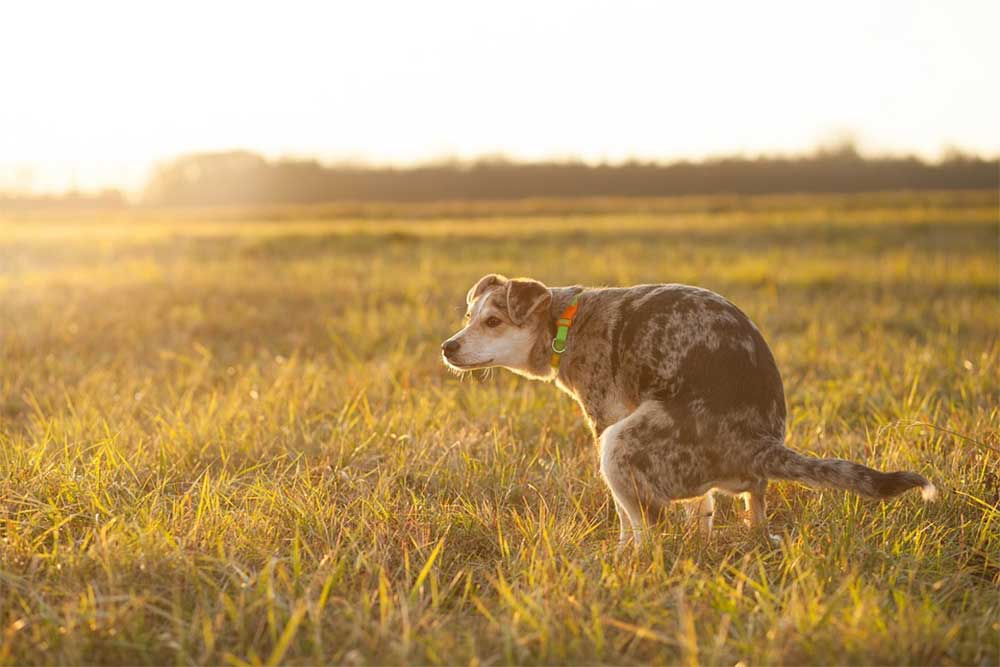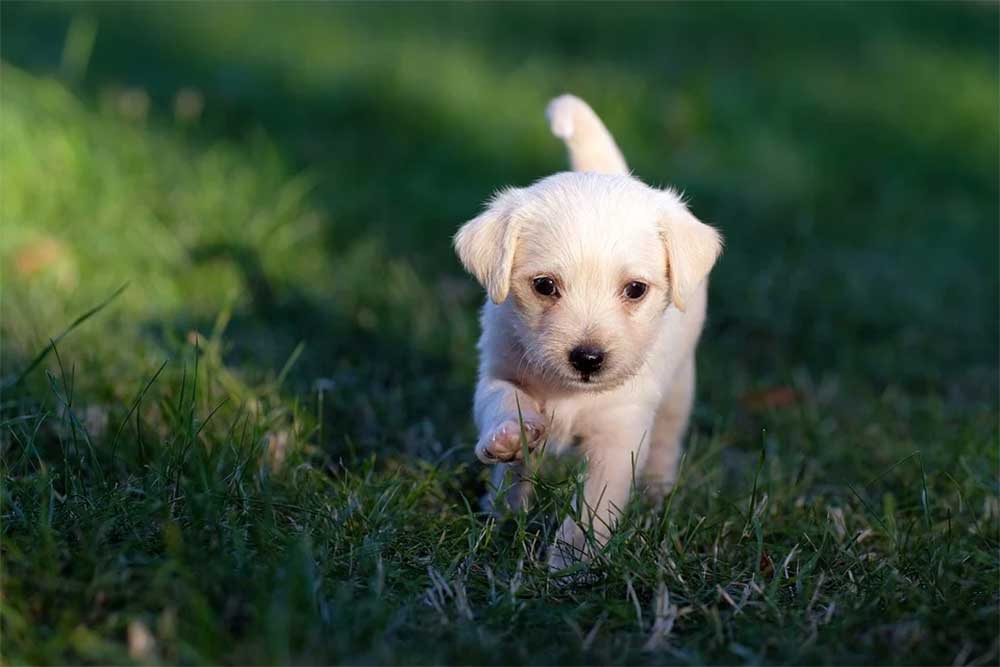Raising a puppy is pretty exciting. There’s nothing quite like watching a puppy as he wiggles on over to you to give you some love and attention. It doesn’t come without its challenges, however.
Anxiety can kick in if you’re a first time puppy owner and you aren’t quite sure about what’s normal and what isn’t. You may find yourself paying a little more attention to your pup’s bowel movements than you may like, and you may find yourself wondering: how many times a day should my puppy poop?
We’re here to put your mind at ease and to let you know how many times your dog should poop a day. We’ll go into this in more depth later in the articles, but here’s a quick guideline.
In general, your puppy will probably poop roughly 5 times each day. This is fine up until your puppy reaches adulthood. Of course, all puppies are different, so what is normal will also differ. With that in mind, here’s everything that you need to know.

How Much Will My Puppy Poop Each Day?
If your puppy is very young then they will likely need to poop more often every day. In general though, your dog should be pooping between one and five times every day, though this depends on what they eat and exactly how old they are.
It’s usually better if your dog goes more frequently. There’s a chance that your dog may be struggling with constipation if they only poop once a day.
Your dog is going to poop a lot less as they get older – which is good news for you since you won’t need to clean as often! Your dog will also learn to hold their movements in for much longer.
It’s worth noting that your dog is probably going to poop far more often during the day if you feed them a diet that’s high in fiber. You will also be able to figure out how many times a day you need to feed your dog based on the amount of bowel movements they have.
Puppies need to be fed a lot more frequently during the day than an adult dog does. Ideally, your pup needs to eat around 3 little meals each day. As such, you should be cleaning up around 3 to 5 poops each day.
What’s Normal?
Now, let’s talk about what puppy poops are normal and which ones aren’t. You need to know about healthy puppy poops in order to ensure that your pooch is healthy, after all!
Your dog’s poop can give you an idea of your dog’s general health and wellbeing. You won’t even need to visit the vets every five minutes because you’ve overanalyzed your pup’s behavior!
Color
So, what color should your dog’s poop be? When you next take a look at your puppy’s poop, you should be making sure that it’s medium to dark brown in color. You can be concerned if the poop is gray, green, black, red, yellow or white in color. This is not normal poop.
Don’t be alarmed if there are green bits in the poop either – this is probably grass. It’s not ideal if your dog is eating grass, but there’s no need to panic about it unless it’s excessive.
You may sometimes see white pieces in your dog’s otherwise normal poop. That’s a little more problematic since it could mean that your dog has a tapeworm inside of him. This is an issue that’s usually easily rectified, however. You just need to give your dog some worming medicine – if you have any doubts, you can ask your veterinarian for some advice.
Keep an eye out for any red poop though. This may indicate that your dog is struggling with internal bleeding, which is a medical emergency. If you notice red poop then you should take your dog to the veterinarian straight away.
Consistency
The best kind of stool is one that’s log shaped and firm. Your dog should not be having diarrhea all the time – this kind of stool is a liquid consistency and it’s usually rather runny. It won’t look like any particular shape.
It’s not a good sign of overall health. Constipation isn’t a good thing either, but it can be hard to determine if your dog is constipated. You may need to watch how the bowel movement comes out of your dog in order to determine if it’s constipation.
When your dog is constipated, you may notice that the dog is stressed as they are trying to poop and the stool may look hard in appearance. Your dog may even start shaking from the strain. The stool can sometimes come out in smaller sections if the dog has been constipated for some time.
Smell
Let’s face it: nobody likes the smell of poop. Sometimes though, you’ve just got to smell the poop to ensure that your pooch is healthy! If the poop smells basically like you think it should, it’s fine.
You do need to make sure that things don’t suddenly change however. It’s not good if the poop smells significantly worse than usual or if it smells sweet. This can be a sign that your dog is suffering with a disease.
You need to keep an eye out for these kinds of changes. If you notice any severe changes with the smell of your dog’s poop, speak to a veterinarian for further advice.
Amount
This may seem obvious, but if you have a bigger puppy then you are going to be cleaning up a larger amount of poop. The amount of poop produced by a labrador puppy is going to significantly differ from what a chihuahua of the same age will produce.
You will notice that your dog will generally produce the same amount of poop each time that they have a bowel movement, but it’s best not to compare the amount to other dogs. Each dog will differ, after all.
There’s usually no need to worry unless your pup is producing a significantly higher or lower amount of poop than usual and they’re eating the same diet as usual.
Knowing When Your Puppy Needs to Have a Bowel Movement

It can often be difficult to figure out what your pup needs since they can’t speak! With that being said though, there are some signs to look out for that will tell you whether your pup is ready for a bowel movement.
In general, you will find that your pup goes for a poop around 30 minutes after they have eaten some food. Many vets will suggest that dogs can hold their bowel movements for one hour for each month of their age. This is applicable up until they hit around 8 months old. For instance, then, a 3 month old puppy may be able to hold their poop for 3 hours.
That doesn’t necessarily mean that your dog will hold their poop for that long. If there’s no explicit need for your dog to hold their bowel movement then they won’t. With that in mind, you should venture to take your dog outside for a poop around 30 minutes after meal time.
Your pup may also need to go and relieve himself when they first wake up and just before they go to sleep at night. If you can predict these bowel movements then it will make it a lot easier for you to toilet train your dog.
If you’re still trying to house train your dog, there are a few signs that you should look out for in order to know when your dog needs to poop.
Crying
Your dog may not be able to speak your exact language, but they’ll still try to communicate with you if something is wrong.
If your dog is whining or howling next to the door or as they walk around the house, it could be that they’re trying to tell you that they need to have a bowel movement.
This can also mean other things like your dog wants some affection or they are hurt, but it’s worth remembering that this is also a sign that your dog needs to poop.
Pacing or Restless Behavior
If your dog looks a little restless and distracted as they walk around the house, they may be trying to find the right place to relieve themselves.
Keep an eye out for when your dog starts to sniff around on the floor too, since this may also be a sign that they are looking to relieve themselves.
After a while, your dog may begin to realize that they are better off relieving themselves outside. In this case, they may begin to pace around the door to indicate that you need to let them out.
Circling
This is one of the last signs that your puppy needs to poop before they do their business.
Circling suggests that your pooch has found the ideal place to relieve himself. This is most certainly not a good sign if the location in question is on a carpet or on some clothes you’ve strewn across the floor.
If you don’t want your pooch to poop in that location, you can give them a stern no and then redirect them to the right place.
Squatting
It’s game over. Your pup is ready to poop. All you can do now is carry your pooch to the right place, praying that they don’t poop while in mid air!
How To Respond to Puppy Poop Changes
It can be rather alarming when your puppy’s poop suddenly begins to change, but what do you do in these situations?
Decreased or Increased Frequency
If the frequency of the bowel movements has changed, this may not necessarily be a bad thing. Dogs will poop less as they get older, so it’s a totally normal occurrence. After 8 months, your dog shouldn’t be pooping nearly as much as they once were.
If your dog is the same age and their diet hasn’t altered, they may be constipated. In this case, make sure that you give your dog food with more fiber or speak to your vet for help. They may give you some medication for your dog to help them to relieve themselves more often.
Diarrhea
Diarrhea is a problem, since your dog can lose water at a rapid rate. Make sure that they’re drinking plenty of water, and take them to the vet if you have any concerns.
A wide range of things can cause diarrhea, so it’s okay to be cautious.
Color Changes
If you’re noticing big changes in the color of your dog’s poop, you need to take action. Figure out if there’s a reasonable answer as to why your dog’s poop has changed in color.
If it’s green, perhaps your dog has been eating grass which isn’t super concerning. If you have any doubts or if there are any especially worrying changes, take your dog to the vet for further advice.
Conclusion
Hopefully this has answered your question about how many times a day a puppy should poop!
They poop a lot, so make sure that you’re prepared. We promise – it gets easier!
